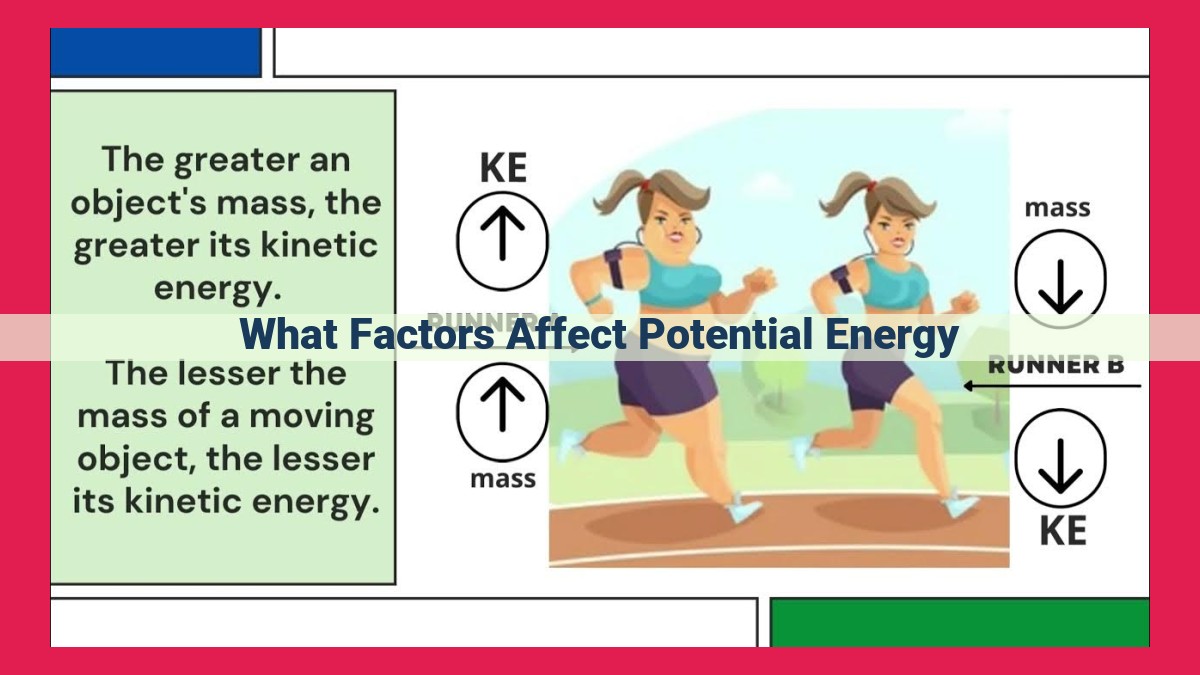Understanding The Factors Impacting Potential Energy: Mass, Height, And Gravity

Potential energy depends on an object’s mass, height above a reference point, and acceleration due to gravity. Mass, influenced by density and volume, determines an object’s gravitational pull, affecting its potential energy. Height signifies an object’s vertical position, with increased elevation leading to greater potential energy due to the work done against gravity. Finally, acceleration due to gravity governs an object’s potential energy, as it determines the strength of the gravitational pull acting on the object.
Mass: The Foundation of Potential Energy
In the realm of physics, mass reigns supreme as the cornerstone of potential energy. Potential energy embodies the energy an object possesses due to its mass and position relative to a reference point. It’s a stored form of energy, awaiting release when an object falls or moves. Understanding the interplay between mass and potential energy is crucial for grasping the fundamentals of mechanics.
Mass, often measured in kilograms, is an intrinsic property of matter, representing the amount of substance it contains. Density, the mass per unit volume, and volume, the amount of space an object occupies, are closely related to mass. Heavier objects generally occupy greater volumes and have higher densities.
The relationship between mass and potential energy is an enduring principle in physics. As an object’s mass increases, so too does its potential energy. This is because mass intensifies the gravitational pull of Earth, the invisible force that draws objects towards each other. The heavier an object is, the stronger the gravitational pull it experiences, and the greater its potential energy.
Height Above Reference Point: Gaining Potential Energy with Elevation
Imagine standing on the ground, holding a heavy object in your hand. The Earth’s gravitational pull exerts a force on the object, keeping it firmly within your grasp. But what if you were to lift the object higher and higher?
As the object ascends, its vertical position changes. It moves away from the Earth’s center and, in turn, gains potential energy. Potential energy is the energy an object possesses due to its position or condition. In this case, the object’s position above a reference point (usually the ground) determines its potential energy.
The higher you lift the object, the more potential energy it acquires. This is because the force of gravity acting on it must do more work to raise it against Earth’s pull. The work done is directly proportional to the object’s mass and the distance you lift it.
Distance, displacement, and position are crucial concepts to understand here. Distance measures the total length of an object’s path, while displacement refers to its change in position. Position describes the object’s location relative to a reference point.
As you lift the object higher, its displacement upward increases, and so does its potential energy. The more work required to lift the object against gravity, the greater its potential energy becomes. This stored energy can be released later when the object falls or is allowed to move due to gravity’s influence.
Acceleration Due to Gravity: The Force That Governs Potential Energy
In the realm of physics, potential energy reigns supreme as the hidden power within objects, unleashing its full force when released. Gravity, the invisible orchestrator, plays a pivotal role in determining this energy reserve.
Every object with mass is subjected to the gravitational pull of the Earth. This invisible force draws objects towards the planet’s center, creating a gravitational field. The acceleration due to gravity, denoted by the constant ‘g’, measures the strength of this gravitational pull.
The correlation between acceleration due to gravity and potential energy is profound. Imagine a ball suspended high above the ground. As it sits motionless, its potential energy is at its peak. Suddenly, the ball is released, surrendering to gravity’s embrace. As it falls, its kinetic energy increases while its potential energy diminishes. This transformation is a testament to the fundamental relationship between gravity and potential energy.
The greater the acceleration due to gravity, the stronger the gravitational pull and the more potential energy an object possesses at a given height. Conversely, a weaker gravitational force results in a lower acceleration due to gravity and diminished potential energy.
Understanding this concept is crucial in grasping a wide array of phenomena, from the flight of rockets to the flow of water. By unraveling the intricacies of potential energy and the role of gravity, we unlock a deeper appreciation for the world around us.